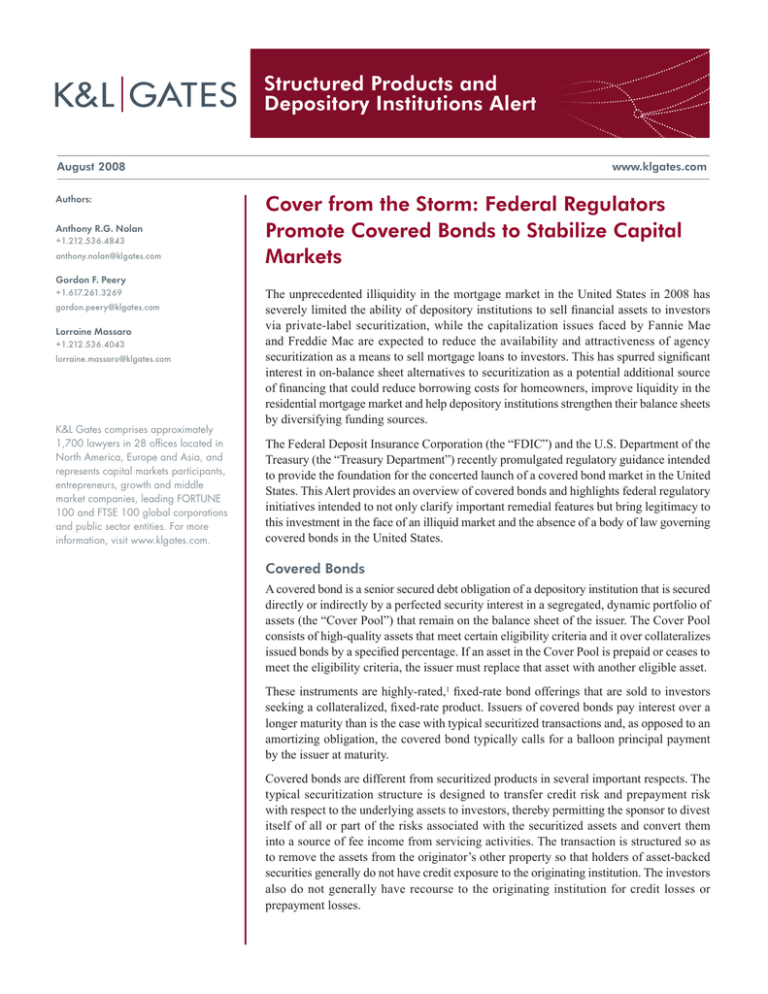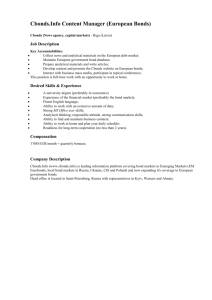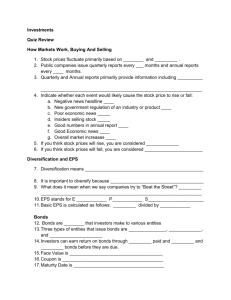
Structured Products and
Depository Institutions Alert
August 2008
Authors:
Anthony R.G. Nolan
+1.212.536.4843
anthony.nolan@klgates.com
Gordon F. Peery
+1.617.261.3269
gordon.peery@klgates.com
Lorraine Massaro
+1.212.536.4043
lorraine.massaro@klgates.com
K&L Gates comprises approximately
1,700 lawyers in 28 offices located in
North America, Europe and Asia, and
represents capital markets participants,
entrepreneurs, growth and middle
market companies, leading FORTUNE
100 and FTSE 100 global corporations
and public sector entities. For more
information, visit www.klgates.com.
www.klgates.com
Cover from the Storm: Federal Regulators
Promote Covered Bonds to Stabilize Capital
Markets
The unprecedented illiquidity in the mortgage market in the United States in 2008 has
severely limited the ability of depository institutions to sell financial assets to investors
via private-label securitization, while the capitalization issues faced by Fannie Mae
and Freddie Mac are expected to reduce the availability and attractiveness of agency
securitization as a means to sell mortgage loans to investors. This has spurred significant
interest in on-balance sheet alternatives to securitization as a potential additional source
of financing that could reduce borrowing costs for homeowners, improve liquidity in the
residential mortgage market and help depository institutions strengthen their balance sheets
by diversifying funding sources.
The Federal Deposit Insurance Corporation (the “FDIC”) and the U.S. Department of the
Treasury (the “Treasury Department”) recently promulgated regulatory guidance intended
to provide the foundation for the concerted launch of a covered bond market in the United
States. This Alert provides an overview of covered bonds and highlights federal regulatory
initiatives intended to not only clarify important remedial features but bring legitimacy to
this investment in the face of an illiquid market and the absence of a body of law governing
covered bonds in the United States.
Covered Bonds
A covered bond is a senior secured debt obligation of a depository institution that is secured
directly or indirectly by a perfected security interest in a segregated, dynamic portfolio of
assets (the “Cover Pool”) that remain on the balance sheet of the issuer. The Cover Pool
consists of high-quality assets that meet certain eligibility criteria and it over collateralizes
issued bonds by a specified percentage. If an asset in the Cover Pool is prepaid or ceases to
meet the eligibility criteria, the issuer must replace that asset with another eligible asset.
These instruments are highly-rated,1 fixed-rate bond offerings that are sold to investors
seeking a collateralized, fixed-rate product. Issuers of covered bonds pay interest over a
longer maturity than is the case with typical securitized transactions and, as opposed to an
amortizing obligation, the covered bond typically calls for a balloon principal payment
by the issuer at maturity.
Covered bonds are different from securitized products in several important respects. The
typical securitization structure is designed to transfer credit risk and prepayment risk
with respect to the underlying assets to investors, thereby permitting the sponsor to divest
itself of all or part of the risks associated with the securitized assets and convert them
into a source of fee income from servicing activities. The transaction is structured so as
to remove the assets from the originator’s other property so that holders of asset-backed
securities generally do not have credit exposure to the originating institution. The investors
also do not generally have recourse to the originating institution for credit losses or
prepayment losses.
Structured Products and Depository Institutions Alert
Unlike holders of asset-backed securities, covered
bondholders have dual recourse in the event of default: holders of covered bonds have a preferential claim to
the Cover Pool and the assets of the issuer, as unsecured
claimants standing pari passu with other unsecured
creditors. Losses are allocated pro rata across covered
bond issuances that utilize a common Cover Pool.
If the Cover Pool is insufficient to satisfy all valid
claims by secured parties, then the amount of the
claims in excess of the pledged collateral would
constitute unsecured claims in receivership. If the value
of the pledged collateral in the Cover Pool exceeds the
amount of all valid claims of secured parties, then
the excess would be returned to the institution or its
insolvency administrator.2 Thus, the critical features of
a covered bond program are the credit risk of the issuer
and the certainty of foreclosure on the Cover Pool.
Global Covered Bond Markets and U.S.
Regulatory Initiatives
The covered bond is an accepted form of financing
in many jurisdictions, primarily but not exclusively
in Europe, which previously established a $3 trillion
market in this security. Germany introduced these
securities, which have been referred to as Pfandbriefe,3
over two hundred years ago to finance public works
projects and other long term projects. France has also
established a significant program for the issuance
of covered bonds, known as obligations foncières.
These programs are authorized by a comprehensive
legislative framework that addresses the terms of
issuance and investors’ rights in the pledged collateral.
A substantial covered bond market has also developed
in the United Kingdom, with contracts originally based
on interpretations of existing laws and regulations
rather than a free-standing legislative framework.
In March 2008, U.K. officials set in place the first
regulatory regime governing covered bonds in the
United Kingdom.4 Canada and Japan also have covered
bond markets grounded in contract interpretations as
opposed to legislation.
European covered bond markets have experienced
deterioration in trading, however. For part of the
trading day on August 16, 2007, some banks in Europe
refused to provide pricing information on covered
bonds to limit losses on widening spreads.5 In late
November 2007, a coalition of European banks agreed
to suspend trading amongst themselves following a
statement by the European Covered Bond Council
which recommended that banks withdraw from
covered bond trades to avoid excessive widening of
spreads.6 In June 2008, sales of covered bonds fell to
17.8 billion euros ($28.3 billion). According to one
index, covered bond prices have fallen 2.5 percent this
year; investors continue to demand premiums to hold
mortgage-backed debt, according to data compiled
by Bloomberg.7 The average yield climbed to 83
basis points over similar-maturity government rates,
from 26 basis points a year ago, according to Merrill
Lynch & Co.’s index of covered bonds outside of
Germany’s market.
Prior to 2008, covered bonds have not been significant
in the United States. Although U.S. banks have
engaged in secured borrowings backed by financial
assets, these transactions have been complicated by
and made relatively expensive because of the lack of a
clear regulatory framework and certainty of treatment
in the event of an issuing bank’s insolvency. The
absence of a covered bond market in the U.S. is due
primarily to the existence of a market for private-label
MBS and Freddie Mac-, Fannie Mae- and Federal
Home Loan Bank System-supported securities. In
the United States, only two financial institutions
have issued covered bonds, largely to investors
outside of the United States: the Bank of America
and Washington Mutual.8 Accordingly, regulatory
uncertainty – principally regarding the treatment of
covered bonds in the insolvency of the issuing bank –
and the use of securitization as a source of financing
effectively stalled the development of covered bonds
in the United States.
On July 15, 2008, the FDIC issued a final policy
statement 9 on covered bonds (the “Final Policy
Statement”) that addresses, among other critical issues,
the treatment of covered bonds in a bank receivership
or conservatorship. On July 29, 2008, in an effort
to increase the use of covered bonds by mortgage
lenders as an alternative to securitization, the Treasury
Department published its Best Practices10 guide (“Best
Practices”) for U.S. covered bonds to clarify and
initiate acceptance of the covered bond structure. The
Best Practices establish a template for U.S. covered
bond issuances and outline additional standards for
covered bonds that are intended to increase investor
confidence in them. Bank of America, Citigroup
Inc., JPMorgan Chase & Co. and Wells Fargo & Co.
announced their support for the Best Practices and
indicated that they are planning to issue covered bonds
August 2008 | 2
Structured Products and Depository Institutions Alert
soon.11 The Securities Industry and Financial Markets
Association announced that it formed the U.S. Covered
Bonds Traders Committee, whose members pledged to
support the growth of the covered bond market in the
United States and play an active role in fostering and
strengthening the market for this instrument.
Thus, federal regulators, key investment banks and a
leading industry group support the emergence of the
covered bond market in the United States during an
era in which major investment banks grapple with
significant capitalization issues, other banks fail,12
government sponsored entities suffer major financial
setbacks and investors and issuers collectively reject
traditional private-label securitization as a source for
mortgage financing.
FDIC Policy Statement: Treatment of
Covered Bonds in Issuer Insolvency
As discussed above, a key consideration in covered
bonds is the treatment of bondholders following
the insolvency of the issuer. In securitization, the
framework for addressing these issues is predicated
on the notion that the securitized assets are transferred
by the issuer in a manner that removes them from its
receivership estate. Through regulations and policy
statements, the FDIC has addressed its treatment of
securitizations in insolvency in a manner with respect
to which the markets have become comfortable.
Because the assets that provide security for covered
bonds remain on the issuing institution’s balance
sheet and the institution retains prepayment risk and
credit risk on those assets (to the extent that it does not
independently hedge those risks), the insolvency issues
for covered bond investors are distinct from those in
a securitization.
FDIC Powers as Receiver or Conservator
Under the Federal Deposit Insurance Act (the
“FDIA”), when the FDIC is appointed conservator or
receiver of an insured depository institution (“IDI”),
parties to contracts with the IDI are prohibited from
terminating most agreements with the IDI because
of the insolvency itself or the appointment of the
conservator or receiver. In addition, contracting parties
must obtain the FDIC’s consent during the forty-five
day period after appointment of FDIC as conservator,
or during the ninety day period after appointment
of FDIC as receiver before, among other things,
terminating most contracts or liquidating any property
of the IDI that is pledged as collateral for secured
transactions. During this period, the FDIC is required
to comply with otherwise enforceable provisions of the
applicable contracts. The FDIC also may terminate or
repudiate any contract of the IDI within a reasonable
time after its appointment as conservator or receiver
if it determines that the agreement is burdensome
and that the repudiation will promote the orderly
administration of the affairs of the insolvent IDI. The
Final Policy Statement provides that the liability of
a conservator or receiver will be limited to the par
value of the bonds issued plus unpaid interest that
has accrued up to the date of the appointment of the
conservator or receiver.13
Scope of Coverage
The Final Policy Statement provides guidance on the
availability of expedited access to collateral pledged
as security for covered bond obligations following
the FDIC’s appointment as conservator or receiver
for an insolvent issuing IDI. Specifically, the Final
Policy Statement clarifies how the FDIC will apply
the consent requirements of Section 11(e)(13)(C)
of the FDIA to such covered bonds to facilitate
the prudent development of the U.S. covered bond
market, consistent with the FDIC’s responsibilities
as conservator or receiver for IDIs.14 As the U.S.
covered bond market develops, future modifications
or amendments may be considered by the FDIC.
The Final Policy Statement applies only to issuances
of “covered bonds,” as defined therein, that are made
with the consent of the issuing IDI’s primary federal
regulator, but only if the issuing IDI’s total covered
bond obligations at such issuance comprise no more
than 4 percent of its total liabilities. For purposes of
the Final Policy Statement, a covered bond is a nondeposit, recourse debt obligation of an IDI having a
term greater than one year and no more than thirty
years, that is secured directly or indirectly by a pool
of performing first-lien mortgages on one-to-four
family residential properties, underwritten at the
fully indexed rate and relying on documented income
and complying with existing supervisory guidance
governing the underwriting of residential mortgages.15
Notwithstanding the foregoing, up to ten percent of the
Cover Pool for a covered bond may consist of AAArated mortgage bonds.
August 2008 | 3
Structured Products and Depository Institutions Alert
The parameters set by the FDIC in its Final Policy
Statement, which appear to reflect the concern by
the FDIC that covered bond defaults may pose a
threat to the FDIC’s insurance fund, have been the
subject of criticism. A focal point of that criticism is
the decision by the FDIC to include only residential
mortgage obligations as eligible collateral supporting
issuances covered by the Final Policy Statement.
Many have argued that the covered bond market in
the United States will not be as robust if it is limited
to covered bonds collateralized only by residential
mortgage obligations – as opposed to commercial
mortgages and other assets such as credit card and lease
obligations.16 Commercial mortgage loans are among
the core lending business of banks that would issue
or sponsor the issuance of covered bonds; however,
those bonds would not receive the same treatment as
bonds secured by eligible collateral in Cover Pools
that come within the parameters of the Final Policy
Statement.17 The historic default rates18 of commercial
loans indicate that this asset class should also be
included in the Cover Pools that come within the Final
Policy Statement. All European jurisdictions permitting
residential mortgages as collateral also permit the use
of commercial mortgage-backed securities as collateral
of cover bonds.19 The use of commercial mortgages
as covered bond collateral is so well-established in
Europe that the European Covered Bond Council does
not differentiate between commercial and residential
mortgage collateral but treats these mortgages as a
single asset class in statistical entries in its Covered
Bond Fact Book.20 Thus, it has been argued that the
narrow scope of the Final Policy Statement limits
the use of the covered bond as an additional funding
strategy for financial institutions.
Market participants view the FDIC’s requirement
that each covered bond issuance comprise no more
than 4 percent of its total liabilities as excessively
restrictive. They have pointed to the fact that in the
United Kingdom, covered bond thresholds of up to 20
percent of the issuer’s total assets have been adopted;
U.K. thresholds are not hard limits, but rather are
trigger points at which an issuer is required to engage in
discussions with regulatory authorities. It is generally
thought that if a covered bond market launches in
the United States, there will be political pressure
to increase the 4 percent limit and perhaps broaden
the collateral base that could be subject to covered
bond issuances.
Consent to Foreclosure on Collateral
An issue of special concern for investors and issuing
IDIs relates to the conditions under which the
FDIC would grant consent to obtain collateral for a
covered bond transaction before the expiration of the
aforementioned forty-five day period after appointment
of a conservator or ninety day period after appointment
of a receiver.21 IDIs interested in issuing covered
bonds have expressed concern that the requirement
to seek the FDIC’s consent before exercising on the
collateral after a breach could interrupt payments to
the covered bond obligee for 90 days or more. IDIs
can provide for additional liquidity or other hedges to
accommodate this potential risk to the continuity of
covered bond payments, but at an additional cost to
the transaction. Interested parties requested that the
FDIC provide clarification about how FDIC would
apply the consent requirement with respect to covered
bonds. Accordingly, the FDIC issued the Final Policy
Statement in order to provide covered bond issuers
with final guidance on how the FDIC will treat covered
bonds in a conservatorship or receivership.
The Final Policy Statement provides that a covered
bond holder can enforce its contractual rights as a
secured creditor against the underlying bonds 10
business days after the FDIC receives a notice of a
“monetary default” on the covered bonds (or after the
FDIC’s repudiation of the bonds if the FDIC has not
first paid them off).22 Note that a “monetary default”
only covers a failure to pay, meaning that covered bond
holders do not gain consent to enforcement owing to
other defaults such as the failure to maintain collateral
having the requisite value, and that it is subject to the
important caveat that there must be no dispute about
what is owed.
Because the FDIC may repudiate a covered bond
contract at any time during the 45-day period or
90-day period after the date of the appointment of the
conservator or receiver, as applicable, investors are
subject to that period plus 10 business days in which
the value of its collateral may deteriorate. Any such
deterioration in value of the collateral may increase
the likelihood that a receiver will decide that it is in
the best interest of the insolvent estate to just let these
bondholders take their (inadequate) collateral rather
than make payments under the bond
August 2008 | 4
Structured Products and Depository Institutions Alert
Treasury Department’s Best Practices for
Residential Covered Bonds
The publication by the Treasury Department of its Best
Practices represents further progress in facilitating
the development of a U.S. covered bond market and
affording in the United States the homogeneity and
simplicity of the regulatory framework for covered
bonds in European countries. Similar to the Final
Policy Statement, the Best Practices provide that an
IDI obtain the approval of its primary regulator as a
condition to being able to issue covered bonds.
Structure and Cover Pool Eligibility
Characteristics
While the Final Policy Statement does not address the
appropriateness of particular means of issuance, the
Best Practices describe two covered bond structural
models that permit the issuer to be either a newlycreated, bankruptcy remote special purpose vehicle
(“SPV”) or an IDI in what the Best Practices document
describes as a “Direct Issuance Structure.” Neither
of these structures is new and many elements of
both build on successful components of structured
products and debt offered for many years. In the case
of the SPV structure (the “SPV Structure”) and the
Direct Issuance Structure, the Best Practices mandate
that the Cover Pool be owned by the IDI. Permitted
structures may include two trustees, a mortgage bond
trustee and a covered bond trustee, an interest rate and
currency swap provider and an asset manager. As for
the collateral underlying the bonds, according to the
Best Practices, collateral in the Cover Pool are to have
these characteristics:
• Mortgages must be current when added to the Cover
Pool; mortgages more than 60-days past due are to
be replaced;
• Maximum loan-to-value (“LTV”) at the time of
inclusion in the pool is set at 80 percent;
• Mortgages from a single Metropolitan Statistical
Area cannot comprise more than 20 percent of the
Cover Pool;
• Negative amortization mortgages are ineligible for
inclusion in the Cover Pool; and
• Bondholders must have a perfected security interest
in the mortgages in the Cover Pool.23
According to the Best Practices, issuers are to maintain
at all times an overcollateralization value of at least
5 percent of the outstanding principal balance of all
Covered Bonds; permitted assets in the Cover Pool
therefore must have a value that is 105 percent of the
aggregate principal balance of Covered Bonds and
asset tests are to be conducted on a frequent basis,
according to the Best Practices.24 Typically, a breach
of an asset coverage test permits the bond trustee to
accelerate the covered bonds against the issuer. In the
near term, as a market for covered bonds develops in
the United States, actual overcollateralization levels
based on eligible collateral may increase to make the
covered bond not only palatable but attractive to the
investor in the current market.
Hedges and Defeasance
According to the Best Practices, covered bonds may
be issued in any currency. Swap providers issuing
currency and interest rate swaps are permitted in the
Best Practice structures to address mismatches between
the frequency of payments and currency differences
with respect to the assets in the Cover Pool and the
payment obligations to the bondholders.25 Interest
payments may be made by financially sound swap
counterparties on a temporary basis in the event that
the issuer becomes insolvent.26 Counterparties may
also provide guaranteed investment contracts, GICs,
whereby the proceeds of Cover Pool assets are invested
at the issuance of the covered bonds in order to prevent
the acceleration of the bonds due to issuer insolvency.27
Investor concern about increases in price due to GIC
and swap features may undercut investor demand for
these bonds, however.
Disclosure
Covered bonds may either be registered in accordance
with or exempt from U.S. securities laws. Transaction
disclosure, according to the Best Practices, is to include
“descriptive information” on the Cover Pool at the time
an investment decision is being made and monthly
after issuance.28
Conclusion
Given the current crisis in secondary mortgage
market liquidity, federal officials clearly recognize
that investors are reluctant to invest in securities
collateralized by mortgages – particularly residential
mortgages – and recent pronouncements go to the head
of investors’ reluctance. Perhaps most importantly,
August 2008 | 5
Structured Products and Depository Institutions Alert
covered bonds structured in the manner set forth in
the Final Policy Statement and Best Practices provide
investors with a better outcome in the event of default.
Accordingly, federal initiatives such as the Final Policy
Statement, the Best Practices and the structures and
remedies that are advanced by those initiatives will
likely accelerate the launch and development of a
robust residential mortgage-backed covered-bond
market in the United States.
7
Shelley Smith and John Glover, “WaMu Shows
Paulson Mortgage Rescue Plan Is Perilous,”
Bloomberg.com (July 22, 2008), available at
http://www.bloomberg.com/apps/news?pid=206
01109&sid=aAAbDzCsg9O4&refer=home.
8
Washington Mutual issued covered bonds in
September 2006 and the Bank of America’s
issuance followed in 2007. In these transactions,
the depository institutions sold mortgage bonds
secured by mortgages to a special purpose
vehicle (“SPV”). The pledged mortgages
remained on the institutions’ balance sheets,
securing the respective institutions’ obligations
to make payments on the mortgage bonds, and
the SPVs in turn issued and sold covered bonds
that were secured by the mortgage bonds. In
the event of a default by either institution, a
mortgage bond trustee would take possession
of the pledged mortgages and continue to
make payments to the special purpose covered
bond issuer to service outstanding covered
bonds. Recently, downgrades of these bonds
have reflected investor concern that they
were vulnerable to a decline in the quality of
residential mortgages, as well as to a concern
about the financial health of the banking sector,
generally. See Shelley Smith and John Glover,
“WaMu Shows Paulson Mortgage Rescue Plan
Is Perilous,” Bloomberg.com (July 22, 2008),
available at http://www.bloomberg.com/apps/ne
ws?pid=newsarchive&sid=aAAbDzCsg9O4.
9
Final FDIC Covered Bond Policy Statement,
Federal Deposit Insurance Corporation, 73 FR
43758 (July 28, 2008) (hereinafter, “Final Policy
Statement”); see also, Financial Institution Letter
of the Federal Deposit Insurance Corporation
(FIL-73-2008)(Aug. 4, 2008) (the “Financial
Institution Letter”).
10
United States Department of the Treasury
Best Practices for Residential Covered Bonds,
Department of the Treasury (July 2008)
(“Best Practices”).
Endnotes
1
Covered bonds typically receive “AAA” or
“AA” ratings from credit rating agencies and
attract a conservative class of investor. Letter
from Dottie Cunningham, Chief Executive
Officer, Commercial Mortgage Securities
Association to Robert E. Feldman, Executive
Secretary of the Federal Deposit Insurance
Corporation, dated June 23, 2008
(the “CMSA Letter”).
2
United States Department of the Treasury
Best Practices for Residential Covered Bonds,
Department of the Treasury at 15 (July 2008)
(“Best Practices”).
3
Pfandbriefe is technically a subset of
covered bonds.
4
Chris Oakly, “Regulated Covered Bond
Regulations: Issues Arising from Interpretation
of the UCITS Directive,” Butterworths Journal
of International Banking and Finance Law at
240 (May 2008).
5
Esteban Duarte and Steve Rothwell, “Europe
Suspends Mortgage Bond Trading Between
Banks,” Bloomberg.com (Nov. 21, 2007),
available at http://bloomberg.com/apps/news?pi
d=20601087&sid=aLzGEmrjr0fA&refer=home.
6
The extra yield demanded by investors to hold
covered bonds sold by German banks instead of
government debt increased 15 basis points in six
weeks. Id.
August 2008 | 6
Structured Products and Depository Institutions Alert
11
Treasury Department Secretary Henry M.
Paulson, Jr., Statement on Covered Bond Best
Practices (July 28, 2008)(“We knew that this
initiative would be successful only if the largest
banks paved the way. And so I welcome the
announcement by America’s four largest banks,
Bank of America, Citigroup, JPMorgan Chase
and Wells Fargo, that they intend to establish
covered bond programs and kick-start this
market in the United States.”), available at http://
www.ustreas.gov/press/releases/hp1101.htm;
see also David Cho, “Treasury, Banks Promote
Covered Bonds,” Washington Post, Jul. 29, 2008
at D1.
12
Joe Adler, “FDIC Defends Handling of IndyMac
Run,” American Banker (July 18, 2008).
13
See the Financial Institution Letter, supra,
endnote 9.
14
See Section 11(e)(13)(C)(right to liquidate
pledged collateral by a depository institution in
conservatorship or receivership without FDIC’s
consent during the 45-day period commencing
on the date of appointment of the FDIC as
conservator and a 90-day period from the date
that the FDIC is appointed as receiver).
15
This includes the Interagency Guidance on
Non-Traditional Mortgage Products, October
5, 2006, and the Interagency Statement on
Subprime Mortgage Lending, July 10, 2007,
and such additional guidance applicable at
the time of loan origination. While the FDIC
declined to adopt a loan-to-value test (the Final
Policy Statement indicates that issuers should
disclose loan-to-value ratios for the Cover
Pool to enhance transparency for the covered
bond market in light of the predictive quality
of loan-to-value ratios in evaluating residential
mortgages), the Best Practices includes and
list Final Policy Statement Requirements, and
separate recommended practices for Cover
Pools, both of which are provided here. These
are the Final Policy Statement requirements; to
come within the coverage of the Final Policy
Statement, collateral with these characteristics is
permitted:
• Performing mortgages on one-to-four family residential properties;
•
Mortgages underwritten at the fully-indexed
rate (the index rate prevailing at origination
plus the margin to be added to it after the
expiration of an introductory interest rate,
if any);
• A limited volume of AAA-rated mortgage
securities, up to 10 percent of the Cover Pool;
• Mortgages are to be underwritten with documented income;
•
Mortgages must comply with existing
supervisory guidance governing the
underwriting of residential mortgages,
including the Interagency Guidance on
Non-Traditional Mortgage Products
(October 5, 2006) and the Interagency
Statement on Subprime Mortgage Lending
(July 10, 2007) and guidance in effect at
origination; and
•
Substitution collateral may include cash
and U.S. Treasury and agency securities “as
necessary to prudently manage the
Cover Pool.”
73 FR 43757-58.
16
See CMSA Letter at 8 (referencing the American
Securitization Forum letter to the FDIC dated
February 26, 2008); commercial mortgage
loans have secured covered bonds in the
European market and legislation in 20 countries
including the United Kingdom permit the use
of commercial mortgages as covered bond
collateral. CMSA Letter at 5.
17
“As of March 31, 2008, FDIC insured
institutions held approximately
$988,732,000,000 of commercial mortgage
loans. The origination of commercial mortgage
loans is part of the care lending business of
[insured depository institutions, or “IDIs”] IDIs.
Moreover the funding of commercial mortgage
loans is vital to the U.S. economy. IDIs have
frequently looked to securitization as a source of
funds for commercial mortgage lending.” CMSA
Letter at 2.
18
See CMSA Letter at 5-6.
August 2008 | 7
Structured Products and Depository Institutions Alert
19
CMSA Letter at 5.
25
Best Practices at 13.
20
CMSA Letter at 5.
26
21
See supra, “FDIC Policy Statement: Treatment
of Covered Bonds in Issuer Insolvency -- FDIC
Powers as Receiver or Conservator.”
Swap providers must be “financially sound
counterparties” whose identities are disclosed
to investors in a manner that is similar to
current practice in mortgage-backed security
transactions. Best Practices at 13.
22
See Section 11(e)(13)(C), endnote 14 and
accompanying text.
27
Best Practices at 13.
23
Best Practices, 73 FR 43757-58 (July 28, 2008).
28
Best Practices at 14-15.
24
According to the Best Practices and for purposes
of calculating overcollateralization only the
80 percent portion of the updated LTV will
be credited towards the overcollateralization
requirement. With respect to mortgages in
the Cover Pool with an LTV of 80 percent or
less, the full outstanding principal value of the
mortgage will be credited. As for mortgages
with an LTV over 80 percent, only the 80
percent LTV portion is credited toward the
overcollateralization requirement imposed by
the Best Practices. Best Practices at 12.
K&L Gates comprises multiple affiliated partnerships: a limited liability partnership with the full name K&L Gates LLP qualified in Delaware and
maintaining offices throughout the U.S., in Berlin, in Beijing (K&L Gates LLP Beijing Representative Office), and in Shanghai (K&L Gates LLP Shanghai
Representative Office); a limited liability partnership (also named K&L Gates LLP) incorporated in England and maintaining our London and Paris
offices; a Taiwan general partnership (K&L Gates) which practices from our Taipei office; and a Hong Kong general partnership (K&L Gates,
Solicitors) which practices from our Hong Kong office. K&L Gates maintains appropriate registrations in the jurisdictions in which its offices are
located. A list of the partners in each entity is available for inspection at any K&L Gates office.
This publication/newsletter is for informational purposes and does not contain or convey legal advice. The information herein should not be used or
relied upon in regard to any particular facts or circumstances without first consulting a lawyer.
Data Protection Act 1998—We may contact you from time to time with information on K&L Gates LLP seminars and with our regular newsletters,
which may be of interest to you. We will not provide your details to any third parties. Please e-mail london@klgates.com if you would prefer not to
receive this information.
©1996-2008 K&L Gates LLP. All Rights Reserved.
August 2008 | 8







